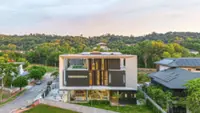The living room exudes a warmer and welcoming ambience after the transformation. Photos: BETA
If you have been following my articles in this column since 2023, you would have noticed that I have written about design principles, design elements and a series of hot tips for home transformations.
Taking advantage of the start of a new year, I will begin a new, curated mini-series on adaptive reuse transformations in Penang and other parts of the world.
For those unfamiliar with the term, adaptive reuse refers to the process of reusing an existing building for another purpose other than which it was originally built for.
For example, an old heritage bungalow can be converted into an office building, cafe, art gallery and so on.
In Penang, we have inherited a rich architectural legacy of colonial buildings ranging from bungalows, shophouses, religious buildings and hotels to transportation premises.
A brief background
Eythrope Penang Hill is a unique two-storey heritage bungalow (Category 2) situated on Penang Hill which enjoys a cooler microclimate with temperatures ranging from 20-27˚C.
Surrounded by lush forests, the 95-year-old building is set within the heart of a recognised Unesco Biosphere Reserve. Built in 1929, Eythrope Bungalow is located within a 10-minute walk from the Penang Hill Funicular Train Station. The building sits on an exclusive edge of the hill with its front facade facing east. This means the house faces a glorious sunrise every morning.
Situated at approximately 820m above sea level, the main frontage enjoys magnificent and unobstructed panoramic views of George Town and Air Itam, plus mainland’s Butterworth, Seberang Perai and Bukit Mertajam.
The existing bungalow has a total build-up of approximately 4,600sq ft (427sq m).
Since 1951, ownership of the bungalow has remained with the same family. Eythrope has been lovingly kept and handed down from generation to generation. It was a private family retreat house, enjoyed only by family members and close friends.
In 2021, the current generation of owners decided to carry out refurbishment works to rejuvenate the old building and transform it into a luxury retreat open to the public to experience a night up at Penang Hill.
Why conserve and adapt?
The transformation of Eythrope was carried out based on the principles of adaptive reuse and conservation. Many may think that conservation and restoration mean the same thing, but they are not.
Restoration is about reinstating the existing building back to its original condition while conservation attempts to preserve the building in its current condition, avoiding further deterioration.
So why conserve and not just build anew?
Eythrope was delicately passed down from generation to generation as a means of preserving architectural legacy and historical values. The owners understood well that heritage buildings are valuable to the younger generations.
It is not only important to generate awareness of the possibilities of adaptive reuse but also to elevate interests in the importance of building less and recycling more.
It is a known fact that buildings are responsible for 39% of total carbon emissions, with 28% from operational emissions and the remaining 11% from materials and construction.
By “recycling” older buildings and avoiding unnecessary new construction, we are indirectly reducing the carbon impact.
Transformation strategies
The scope of work defined by the owners was to repair the building, rejuvenate the interiors, add an extension to the kitchen and adapt the family home to welcome guests.
The architect observed how the existing dark timber tone made the interiors less welcoming.
It was then recommended to remove all existing dark timber varnish by sanding down the existing wooden floor to reinstate the original timber tone.
All broken wooden window frames and doors were faithfully refurbished and carefully reinstated. Existing bathrooms had all their worn-out tiles upgraded with contemporary stone finishes.
The existing external lawn was also spruced up with safety perimeter glass railings and timber decking to create a welcoming al-fresco viewing platform.
The architect also chose a humble and honest approach where the existing arches were accentuated and celebrated as a focal point.
Colour tones were deliberately curated to exude a calming yet luxurious vibe for a restful stay on the hill.
Every room has a window worth looking through. Each window frames a priceless vista of nature, the city of George Town or Penang Bridge. That itself became the main inspiration of the transformation.
Hence, all main bedrooms contain beds that face east, greeting the daily sunrise every morning. Instead of imposing foreign design influences, the architect focused primarily on amplifying the sense of place of every room.
The entire transformation of the old building to its rejuvenated state took 20 months to complete, in 2022. The adaptive reuse strategies utilised are a sustainable approach to ensure the bungalow is kept relevant and adaptable to modern use.
Since 2023, the nine-decade-old building has been open to the public, enjoying a second lease of life, on track for her 100th centenary celebrations.
Tan Bee Eu is a professional architect and interior designer registered with Lembaga Arkitek Malaysia with over two decades of professional practice. She also teaches at Universiti Sains Malaysia and is a frequent keynote speaker at architectural forums and juror of international awards. She can be reached at www.betadesignz.com/contact.















